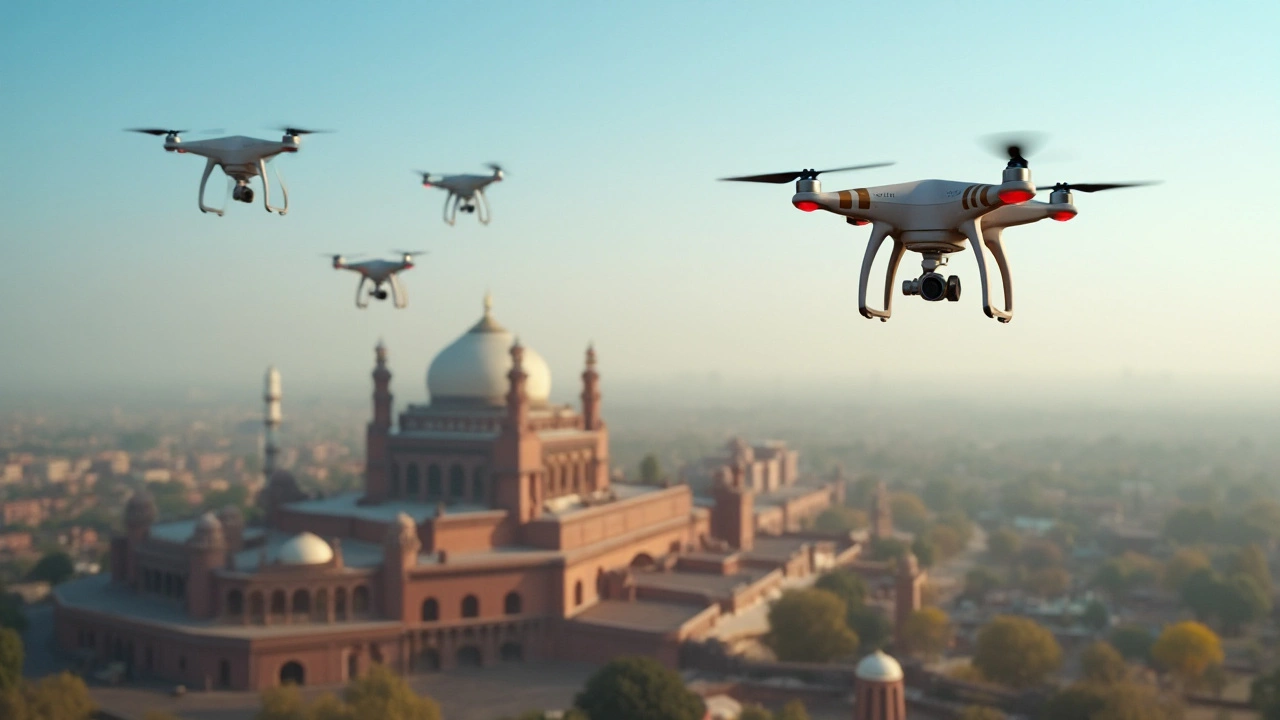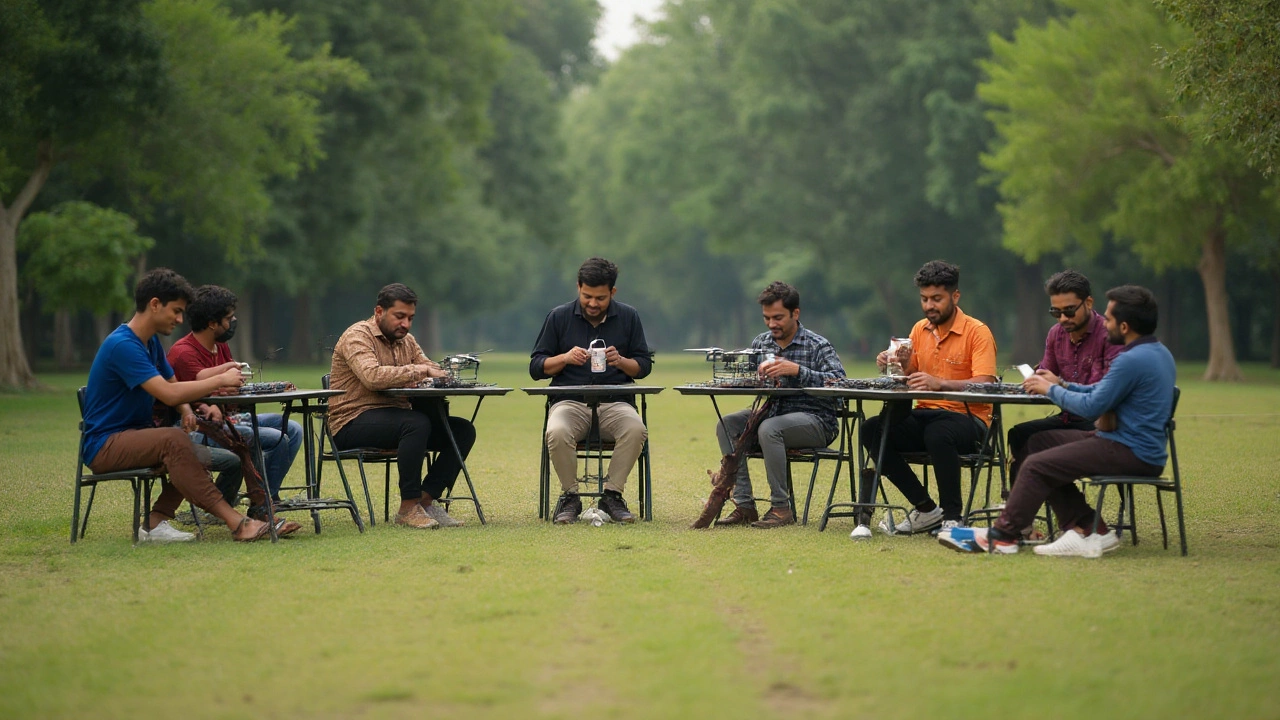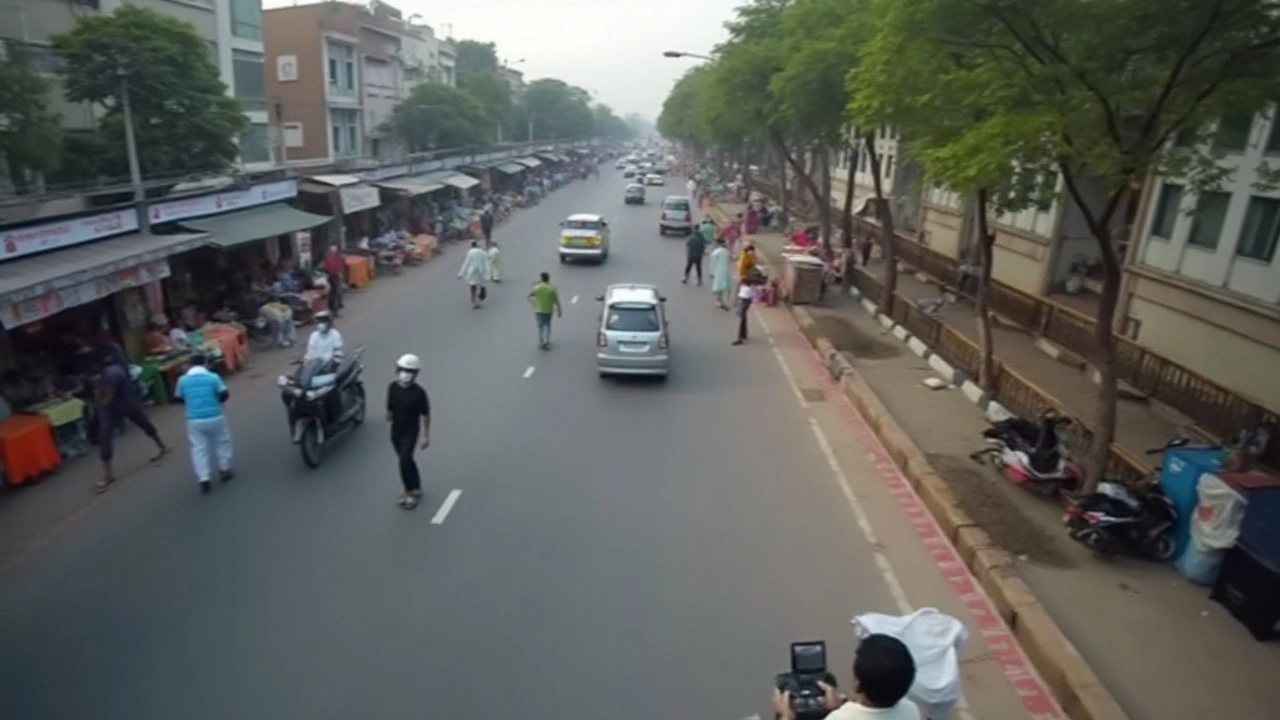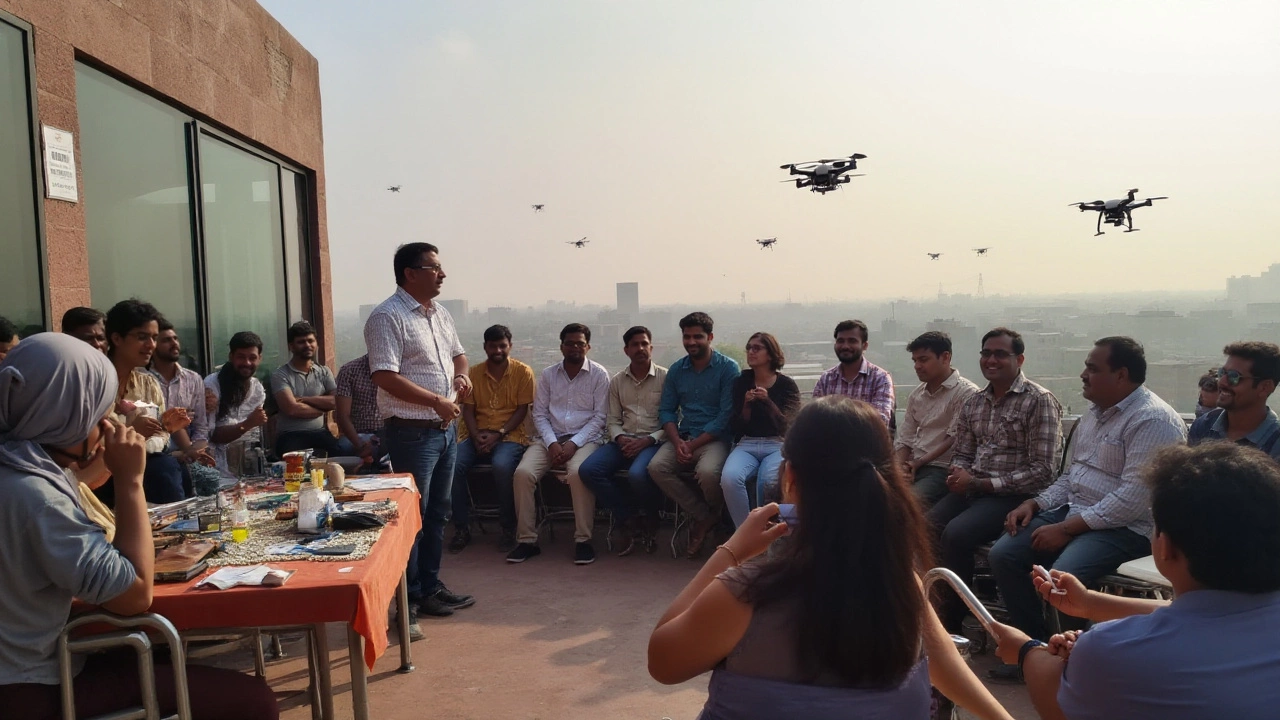Drone Regulations and Photography Tips in Delhi
 Jan, 25 2025
Jan, 25 2025
Delhi, with its sprawling urban landscape, historic monuments, and vibrant culture, offers a diverse canvas for drone photography. However, flying drones in this metropolis comes with a unique set of guidelines and restrictions that every drone enthusiast must be aware of.
The Directorate General of Civil Aviation (DGCA) in India has outlined specific regulations that govern the use of drones throughout the country, including the capital city. Understanding these regulations is crucial not only for legal compliance but also for ensuring the safety and privacy of those on the ground.
Whether you're a professional photographer seeking the perfect aerial shot or a hobbyist looking to explore new perspectives, navigating the rules around drone usage in Delhi can be daunting. But with the right information and preparation, you can soar above the city’s bustling streets, capturing shots that reflect the pulse of India’s iconic capital.
- Understanding Drone Regulations in Delhi
- Permissions and Legal Requirements
- Safety and Privacy Considerations
- Tips for Drone Photography in Delhi
Understanding Drone Regulations in Delhi
Flying drones in Delhi requires a clear understanding of the rules set by the DGCA to ensure both compliance and safety. These regulations are crucial for maintaining airspace security and protecting citizens' privacy. The laws categorize drones into different classes based on their weight, and each category has its own set of permissible activities and requirements. Nano drones, weighing less than 250 grams, have the least restrictions, whereas larger drones require more rigorous checks.
Before you take to the skies, you must register your drone with the DGCA and obtain a Unique Identification Number (UIN). This step is a critical part of ensuring that all drones can be tracked and managed effectively. Interestingly, Delhi's location requires operators to be particularly mindful of the numerous no-fly zones, such as areas near airports, military bases, and certain government buildings. Violations of these airspace restrictions can lead to severe penalties.
To fly a drone legally, an operator often needs to secure a permission known as the Unmanned Aircraft Operator Permit (UAOP), especially for drones above 250 grams. This process, although seemingly bureaucratic, is streamlined through an online portal, making it easier for drone enthusiasts to get the green light. Flying drones in Delhi also demands adherence to specific flight conditions: daylight operations are a must, and drones should be kept within the visual line of sight at all times.
The Delhi government has amplified the emphasis on safety by mandating certain technological features in drones. Features like 'No Permission, No Takeoff' (NPNT) can prevent unauthorized flights, illustrating a proactive approach to risk management. This initiative has been applauded for its foresight. According to an article in The Hindu, "The implementation of NPNT is a game-changer in regulating drone operations, balancing innovation with control."
As the city evolves into a smart city, such measures are necessary to ensure technological advancement doesn't compromise public safety," says Vijay Kumar, a leading aviation expert.
Operators must also comply with clear privacy protocols, particularly when flying drones for photography. Capturing images over private properties without consent can lead to legal issues. This requirement reflects a global emphasis on data privacy, a vital component of modern-day drone regulations. Familiarizing oneself with these rules is not only about compliance but also about being a responsible member of the aviation community.

Permissions and Legal Requirements
Flying a drone in a bustling city like Delhi isn't just about having the right equipment; it's also crucial to be on the right side of the law. The drone regulations Delhi has in place are designed to ensure safety, security, and privacy for all its residents. The Directorate General of Civil Aviation (DGCA) is the authority that oversees and enforces these rules. First and foremost, any drone enthusiast must register their drone with the DGCA through the Digital Sky Platform. This registration process is not merely a bureaucratic exercise; it ensures the drones are identifiable and traceable, a crucial factor in case of any incidences or breaches.
Once the registration is complete, pilots are required to obtain an Unmanned Aircraft Operator Permit (UAOP) for most types of drones. Notably, nano drones, which weigh less than 250 grams, are exempt but must be flown in the visual line of sight and under 15 meters altitude. However, for heavier drones, this permit becomes non-negotiable. It is essential to note that obtaining the UAOP involves a fee and sometimes takes several weeks for approval, so planning ahead is advisable for those looking to capture drone photography on a deadline.
Apart from these permits, drone pilots must also be familiar with the concept of no-fly zones, especially in a city like Delhi, where there are multiple sensitive areas. These zones typically include areas around airports, military installations, and government buildings. Violating these zones, whether intentionally or accidentally, can lead to severe penalties, including hefty fines and jail time. To avoid such pitfalls, the Digital Sky Platform provides a detailed map highlighting these restricted zones. "Adhering to these rules isn't just about legal compliance; it's about the ethics of sharing airspace with others," explains a representative from DGCA.
Drone operators must also adhere to the time restrictions set by the DGCA, which means flying is only permitted during daylight hours, generally between sunrise and sunset. Flying beyond these times, especially at night, requires additional approvals and is highly scrutinized. For enthusiasts interested in night-time drone photography India offers, knowing these nuances could make or break their project.
Lastly, respecting privacy is paramount. Capturing images of individuals or private properties without consent is prohibited. While aerial photography provides unique perspectives, it's vital to ensure that the subjects’ privacy is not infringed upon. Being transparent about one's photography intentions often helps in gaining trust and necessary permissions from property owners.

Safety and Privacy Considerations
When it comes to flying drones in the bustling city of Delhi, considerations for safety and privacy cannot be overstated. The sheer density of the capital means that one wrong move could have significant implications. With drones becoming more accessible, responsible usage has become the cornerstone of UAV (Unmanned Aerial Vehicle) operations. Thus, understanding and adhering to the local rules and the guidelines set by the DGCA is crucial. The organization has implemented a range of measures intended to safeguard not only the operator but also the public. For instance, every drone flight must be conducted in visual line-of-sight, ensuring the user has full control and awareness of the environment.
Privacy is another area that demands attention, given the potential for drones to inadvertently capture sensitive information or invade personal spaces. Avoiding flying over private properties without explicit permission is an example of respecting privacy. Indeed, ethical drone piloting insists on not intruding upon others' lives. Recording images or videos without permission can lead to legal repercussions. An understanding of the distinction between public and private areas is essential, and facilities like embassies, military installations, and critical infrastructure are typically designated as no-fly zones, signifying the importance of being well-informed about these locations.
The Importance of Safety Measures
In a densely populated area like Delhi, one of the pivotal safety measures includes maintaining a safe distance from people, wildlife, and other aircraft. The DGCA has prescribed a minimum vertical distance of 120 meters for drones to keep away from manned operations. These safeguards are intended to minimize mishaps and foster a secure environment. Another salient point to account for is the weather. Given the monsoon seasons and occasional fog during winters, drone operators must check weather predictions before planning their flights. A well-thought-out pre-flight checklist ensures readiness and enhances safety during operations.The renowned aviation expert John Doe once remarked, "Safety isn't just a set of rules; it's a mindset. The best drone pilots are those who respect air and ground equally."
Cultural Significance and Ethical Filming
Delhi is not just a bustling city but a mosaic of cultural and historical significance. Therefore, it becomes crucial that drone pilots exercise discretion when capturing images. Areas of religious and cultural significance demand a higher degree of respect and mindfulness while flying drones. Pilots should avoid any disruption during cultural events or in areas of religious importance. The spirit of responsible drone operation aligns with ethical practices that honor both the people and the places they photograph. To facilitate this, operators can engage with local communities and authorities to gain deeper insights and permissions, fostering a positive acceptance of drone technology.Lastly, being proactive in understanding updates to drone regulations will keep you in line with the evolving landscape of legal frameworks, ensuring both your actions and your art share a positive impact. A consciousness of these considerations transforms drone photography into a safe, creative, and community-respective pursuit, allowing operators to explore without crossing ethical or legal boundaries.

Tips for Drone Photography in Delhi
Capturing the vibrant energy of Delhi through drone photography can be a thrilling endeavor. But before you launch your drone into the skies, there are several key factors to consider that can enhance your experience and ensure compliance with local regulations. The first step is to understand the importance of location planning. Delhi, being a densely populated city, has a mix of architectural gems and bustling streets. Carefully selecting your location, such as the lush gardens of Lodhi or the historical aura around India Gate, can set the stage for mesmerizing captures. Be mindful of avoiding 'no-fly zones' around government buildings and military areas.
Timing is another crucial element when creating awe-inspiring drone shots in the city. The golden hours during sunrise and sunset offer the best lighting conditions for photography. The soft, diffused natural light during these times can add a magical touch to your photos, capturing the city in all its glory without harsh shadows or overexposed highlights. Always check the weather conditions before a shoot, as Delhi can have unpredictable weather patterns, particularly during monsoon season. Drone photography India offers an exciting avenue to express creativity, but it also demands a technical understanding. Knowing your drone's features and camera settings, such as ISO, exposure, and white balance, will significantly impact the quality of your images. Practicing your flying skills in less crowded open areas can help build your confidence and result in more steady shots.
Battery management is also essential, especially in a sprawling city like Delhi where distances between good vantage points can be vast. Carrying extra batteries and strategically planning your shots can prevent lost opportunities due to power shortages. Remember, each flight should not just be about capturing images but also ensuring the safety of people around you. Respecting local rules and maintaining a reasonable distance from crowds is paramount. Privacy concerns should also be addressed, so always ask permission if you plan to capture private properties.
"Photography is more than a medium for factual communication of ideas. It is a creative art," said Ansel Adams, and when it comes to drone photography, this holds exceptionally true.
- Check and update your drone's software before the flight.
- Always have a spotter with you to maintain a visual line of sight.
- Utilize the latest apps to study air traffic and weather conditions.
- Focus on composition techniques such as leading lines and symmetry, which can be particularly effective in urban landscapes.
- Finally, be patient. The perfect shot may require time and multiple attempts.
Drone enthusiasts and professional photographers alike will find that with a bit of preparation and respect for the local regulations, flying drones in Delhi can be an immensely rewarding experience. Whether it's the intricate network of roads viewed from above or the serene expanse of the Lotus Temple, Delhi offers limitless opportunities for breathtaking aerial photography.